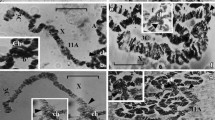Abstract
In position-effect variegation euchromatic genes are brought into the vicinity of heterochromatic sequences as a result of chromosomal rearrangements. This results in the inactivation of these genes in a proportion of cells causing a variegated phenotype. Tartof et al. (1984) have shown that the flanking heterochromatin in the w m4variegating rearrangement in Drosophila melanogaster is homologous to the Type I inserts found in some portions of the rDNA repeats. We have studied the functional properties of these sequences using 51 revertant chromosomes, several variant lines of w m4, strong enhancer mutations of position-effect variegation and X heterochromatin deletions. Our results suggest an array of tandemly repeated sequences showing additive effects and probably subject to magnification and reduction in number. Since only 3 of the 51 revertants isolated do not show variegation if strong enhancer mutations are introduced, only a very short sequence must be essential for the induction of white gene inactivation in w m4. This suggests that the heterochromatic junction itself is sufficient to initiate the variegation of an adjacent gene. Parental source as well as paternal effects on the activity of these sequences have been detected. Revertant chromosomes of w m4can be found after P-directed mutagenesis in hybrid dysgenic crosses suggesting mobile genetic elements at the breakpoints of inversion w m4. These results are discussed with respect to the structural basis of positioneffect variegation as well as the function of certain heterochromatic sequences.
Similar content being viewed by others
References
Ananiev EV, Gvozdev VA, Ilyin VYu, Tchurikov NA, Georgiev GP (1978) Reiterated genes with varying location in intercalary heterochromatin regions of Drosophila melanogaster polytene chromosomes. Chromosoma 70:1–17
Baker WK (1968) Position-effect variegation. Adv Genet 14:133–169
Dawid IB, Long ED, DiNocera PP, Pardue ML (1981) Ribosomal insertion-like elements in Drosophila melanogaster are interspersed with mobile sequences. Cell 25:399–408
Demerec M, Slizynska H (1937) Mottled white 258-18 of Drosophila melanogaster. Genetics 22:641–649
Demerec M (1940) Genetic behavior of euchromatic segments inserted into heterochromatin. Genetics 25:618–627
Engels WR (1983) The P family of transposable elements in Drosophila. Annu Rev Genet 17:315–344
Gerasimova TI, Mizrokhi LJ, Georgiev GP (1984) Transposition bursts in genetically unstable Drosophila melanogaster. Nature 309:714–715
Green MM (1960) Comparative mutability of wild type isoalleles at the white loci in Drosophila melanogaster. Genet Res 1:452–461
Hartmann-Goldstein IJ (1967) On the relationship between heterochromatization and variegation in Drosophila with special reference to temperature-sensitive periods. Genet Res 10:143–159
Kaufmann BP (1942) Reversion from roughest to wild type in Drosophila melanogaster. Genetics 27:537–549
Khesin RB, Bashkirov VN (1978) Maternal influence upon the v-type gene position effect in Drosophila melanogaster. Mol Gen Genet 163:327–334
Lindsley DL, Grell EM (1968) Genetic variations of Drosophila melanogaster. Carnegie Inst Washington Publ 627
Muller HJ (1930) Types of visible variations induced by X-rays in Drosophila. J Genet 22:299–334
Noujdin NI (1944) The regularities of the heterochromatin influence on mosaicism. The hypothesis of the structural homozygosity and heterozygosity. J Gen Biol (in Russian) 5:357–388
Peacock WJ, Appels R, Endow S, Glover D (1981) Chromosomal distribution of the major insert in Drosophila melanogaster 28S rRNA genes. Genet Res 37:209–214
Prokovyeva-Belgovskaya AA (1947) Heterochromatisation as a change of chromosome cycle. J Genet 48:80–98
Reuter G, Wolff I (1981) Isolation of dominant suppressor mutations for position-effect variegation in Drosophila melanogaster. Mol Gen Genet 182:516–519
Reuter G, Werner W, Hoffman HJ (1982a) Mutants affecting position-effect heterochromatinization in Drosophila melanogaster. Chromosoma 85:539–551
Reuter G, Dorn R, Hoffmann HJ (1982b) Butyrate sensitive suppressor of position-effect variegation mutations in Drosophila melanogaster. Mol Gen Genet 188:480–485
Reuter G, Hoffmann HJ, Wolff I (1983) Genetic study of position-effect variegation in Drosophila melanogaster: In(1)wm4 as a standard rearrangement for the isolation and characterization of suppressor and enhancer mutants. Biol Zbl 102:281–298
Ritossa F (1976) The bobbed locus. In: Ashburner M, Novitski E (eds) The genetics and biology of Drosophila, vol 1b. Academic Press, New York, pp 801–846
Sinclair DAR, Mottus RC, Grigliatti TA (1983) Genes which suppress position-effect variegation in Drosophila melanogaster are clustered. Mol Gen Genet 191:326–333
Spofford JB (1959) Parental control of position-effect variegation. I. Parental heterochromatin and expression of the white locus in compound-X Drosophila melanogaster. Proc Natl Acad Sci USA 45:1003–1007
Spofford JB (1976) Position-effect variegation in Drosophila. In: Ashburner M, Novitski E (eds) The genetics and biology of Drosophila, vol 1c. Academic Press, New York, pp 955–1018
Spradling AC, Rubin GM (1981) Drosophila genome organization: conserved and dynamic aspects. Annu Rev Genet 15:219–264
Tartof KD (1974) Unequal mitotic sister chromatid exchange as the mechanism of ribosomal RNA gene magnification. Proc Natl Acad Sci USA 71:1272–1276
Tartof KD, Hobbs C, Jones M (1984) A structural basis of variegating position effects. Cell 37:869–878
Wellauer PK, Dawid IB, Tartof KD (1978) X and Y chromosomal ribosomal DNA of Drosophila: comparison of spacers and insertions. Cell 14:269–278
Author information
Authors and Affiliations
Rights and permissions
About this article
Cite this article
Reuter, G., Wolff, I. & Friede, B. Functional properties of the heterochromatic sequences inducing w m4position-effect variegation in Drosophila melanogaster . Chromosoma 93, 132–139 (1985). https://doi.org/10.1007/BF00293160
Received:
Revised:
Issue Date:
DOI: https://doi.org/10.1007/BF00293160




